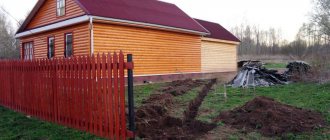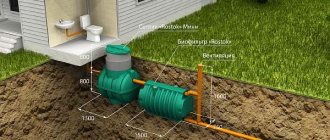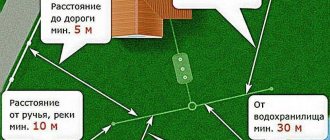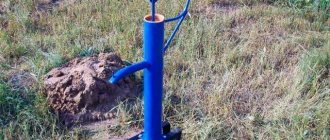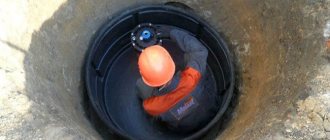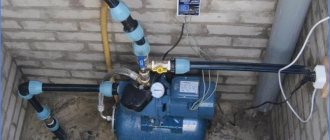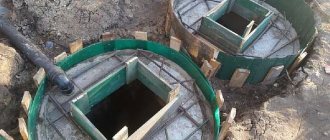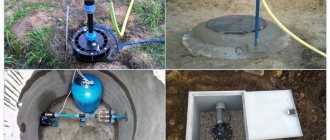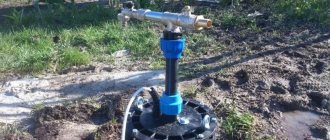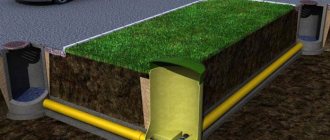Choosing a location for a well on a personal property is a difficult and extremely responsible process. Not only the costs of developing a water source and the convenience of its subsequent operation and maintenance, but also the quality and quantity of water will depend on the correctness of the decision.
The quality and quantity of water depends on the choice of location for the well.
Why do you need to maintain the distance from the well to a residential building and other objects?
The well is the source of water for the house. The quality of drinking water must meet sanitary standards. Drinking low-quality water can cause serious harm to health. Sanitary regulations make the risk of contamination minimal.
SanPiN specifies the requirements for the distance of the well from the house and other objects. What risks arise if you do not maintain the specified distance:
- Getting viruses and bacteria into drinking water.
- Contamination of liquid with mineral fertilizers.
- Ingress of organic waste into the aquifer.
- Flooding of the foundation of a house and outbuildings.
- Damage to pipes and cables by growing tree roots.
The water supply system can be a source of danger. If errors are made during installation of equipment, there is a risk of flooding of the area. The distance from the well to the house protects the foundation from possible flooding and erosion.
Table with distances from the well to the house and other objects
The standards in force in 2021 are shown in the following table:
| Object on the ground | Minimum distance to well (m) |
| Trees (fruit or forest) | 3 |
| Garden, vegetable garden or greenhouse that requires fertilizers | 20 |
| Territory boundary (fence) | 3-4 |
| Wall of the main building (dacha or cottage) | 4 |
| Wall of an outbuilding (garage, summer kitchen, etc.) | 14 |
| Septic tank, cesspool, compost pit | 30-50 |
| Large reservoir | 30 |
| Small body of water: lake, pond, river | 10 |
| Country (dirt) road | 5 |
| Road or railway | 300 |
The above standards apply not only within one area. For example, if a septic tank is installed on a neighbor’s property, the distance from it to the well should not be less than 30 meters. If the selected location does not meet the standards, problems may arise with the preparation of documents for the source.
Buden is interested: What is a well passport.
Figure 1: Distance from the well to other objects on the site
Responsibility for non-compliance with SNiP and rules
The construction of wells in a suburban area must, along with construction standards, also comply with legislative sanitary rules - SanPiN. This is especially true for cesspools, which require some care.
Any type of septic tank or waste pit must be cleaned twice a year with a sterilizing mixture. This is done after pumping out with a sewer truck. A special solution is used, which contains acid and gentle compounds.
Violation of sanitary rules is subject to a fine and, in some cases, a court order to remove the septic tank from the site.
How much space is required to accommodate a drilling rig?
We use URB-2A2 drilling rigs based on ZIL trucks. The width of the drilling machine is 2.5 m, length 8.7 m. Additional space around the drilling machine is required for work.
To develop the artesian horizon, a minimum of 4 * 9 meters of area is required. There should be no electrical or telegraph wires above the selected point. The height of the drilling machine mast is 4 meters when folded and 8.4 meters when in working condition.
The drilling machine can only enter the site through a wide gate. Entry width: from 3 m. It is worth considering the trajectory of the car along the site. Check whether she can drive to the point chosen for the well. Will green spaces and landscape design elements be damaged upon entry?
Auxiliary vehicles are also sent to the site: a truck with materials and tools, a mobile change house for the team. These vehicles may remain outside the territory.
Buden is interested: How to determine the water level in a well.
Figure 2: What space is needed for the drilling rig to move in?
What else does a site owner need to know?
We advise drilling for water as far as possible from the property line. This will protect the artesian well during redevelopment in neighboring areas. Neighbors may place a septic tank or poultry house near the fence, which will jeopardize the purity of drinking water.
Drilling at a distance from the fence will help you avoid conflicts with neighbors.
When choosing a place for water drilling on your site, consider the presence of power lines, telegraph poles and other obstacles. The height of the drilling machine with the mast folded is 4 m, and in working condition - 8.4 m. There should be no obstacles to the operation of the machine above the selected location.
If the distance from the house to the well is not observed according to the standards, then problems may arise when obtaining a technical passport. If the septic tank is located too close to the source, the owner of the site may receive a fine.
It is prohibited to drill for water at the lowest point of the site. This is a separate rule that does not depend on the distance to other buildings.
What to do if there is no room for large drilling equipment?
In small areas it can be difficult to place the URB-2A2 drilling machine. If entry of a drilling machine is impossible without serious damage, a small-sized installation can be used. We use compact drilling machines MOZBT M4. Dimensions of special equipment: 5.2 * 1.5 m, which is comparable to the dimensions of a car.
Prices for drilling with a small-sized drilling rig can be found here.
Using a small-sized installation, you can drill to a depth of 160 m. After work, the landscape design is preserved. The equipment easily enters the site and maneuvers within its territory. A team of two people is enough to operate the drilling rig.
Instead of wheels, the MOZBT M4 has a chassis. Thanks to the chassis, the weight of the machine is distributed more evenly. After driving and parking the drilling machine, the lawn is quickly restored. It does not cause damage to garden paths. When ordering a small-sized installation, the price per 1 m of well increases slightly (by 200-300 rubles).
Figure 3: What place is needed for MGBU check-in?
Empirical ways to find groundwater
These methods include various methods that have proven themselves in the search for groundwater in areas of various types. To implement these methods, special equipment, measurements and analysis of the information received are required.
Despite their high accuracy, these methods also do not provide a 100% guarantee, however, in combination with visual signs, they can be considered reliable with complete confidence.
Empirical methods for searching for an aquifer and determining the location of a future well are usually based on initial visual observations
Method #1 - using a clay pot
An ancient method that our ancestors used to find underground water. The principle of operation of this method is as follows: a dry clay pot is taken and placed for a day in the expected location of the aquifer.
If after a day the inside of the pot fogged up and its walls became wet, then it was concluded that the water was close to the surface of the earth.
This method can be used in dry, warm weather. To obtain more accurate results, it is recommended to use several clay pots, comparing their condition after a day, which pot is the most wet inside, in that place and the depth of the aquifer is less.
Adherents of this method advise using a clay pot to get the right result. And do not neglect the advice on placing 3-5 pots on the site at the same time in order to immediately compare the degree of their moisture
Method #2 - using silica gel
Silica gel is a synthetic polymer substance that can absorb moisture from the environment. Before use, the substance must be thoroughly dried if it has been stored open. Silica gel is placed in a bag made of natural fabric and weighed; it is enough to take 100-300 g.
After this, the bag (or several bags) is buried at the points where the water-bearing well is supposed to be located at a depth of 0.8-1 m. After a day, the bags of silica gel are dug up and weighed.
In the place of greatest saturation with water, silica gel will absorb the greatest amount of moisture, which will affect its weight; it will increase by 1.5-3 times. The greater the increase in weight, the closer to the surface the aquifer lies.
Instead of silica gel, you can use any desiccant, for example, pre-crushed and dried clay brick.
Silica gel is part of pet litter, so you can use regular polymer litter from a pet store to find groundwater.
Method #3 - electrical probing
To search for groundwater using this method, special equipment is required. In this case, it is impossible to do the search yourself; you will have to turn to professionals, however, the reliability of this method is very high.
The operating principle is as follows:
- soil resistivity measurements are taken at different points on the site;
- As a result of research, the aquifer is determined.
Groundwater is recorded in the place where instrument readings range from 50 to 200 Ohms. The method is not suitable if there are underground communications and metal structures on the site, because devices will give unreliable results.
The use of equipment allows you to obtain reliable results. True, metal objects that accidentally end up in the ground will negate all research
Method #4 - frame search
The dowsing method is the most famous and at the same time controversial method. Some experts consider it effective and scientifically based, while others call it quackery. However, there are many documented cases where groundwater was found using dowsing.
To implement this method, it is necessary to prepare a frame of aluminum wire 50 cm long. The ends of the wire are bent at right angles. The frame is inserted into the branches of viburnum, hazel or elderberry.
Next, perform the following steps:
- Using a compass, we determine the cardinal directions and mark them on the site.
- We slowly cross the area from north to south, and then from east to west, holding the dowsing frame in our hands.
- At the location of the aquifer, the frames will begin to move.
- Moving in different directions and following the movement of the frame, we determine the direction of the aquifer.
The use of a frame is based on the action of magnetic fields, so this method is not suitable if the soil of the site contains a large amount of iron ore or there are radar towers nearby that distort the data of the frame biolocator.
Instead of an aluminum frame, you can use vine branches, which are highly sensitive to fluctuations in magnetic fields in the presence of an aquifer
All the methods discussed above are widely used to search for an aquifer and determine the location of drilling a shallow well or an Abyssinian well. However, as already mentioned, none of them gives a guarantee that when you start drilling, you will encounter groundwater at the expected depth.
Is there a way to determine the groundwater horizon in a particular place? Is it possible to accurately determine the depth of an aquifer? Yes, if you use the exploratory drilling method.
Approval of a new water-bearing well
Before starting work, you need to agree on the well design. Main stages of approval:
- Collection of cadastral documents for the area where the work is being carried out.
- Calculation of the level of consumption of natural resources.
- Approval of the project by Rospotrebnadzor.
- Drawing up a conclusion on the feasibility of design.
- Drawing up a design for a hydraulic structure.
- Carrying out drilling operations.
- Chemical analysis of liquid.
- Preparation of a source technical certificate.
- Registration of the building for cadastral registration.
Our company helps collect documents and carry out approvals. We do turnkey work. All you have to do is set a task: choose the type of horizon and casing material. Our company will solve the remaining issues. You will receive a working water supply system without unnecessary problems.
Buden is interested: How many meters can you drill a well without a permit?
Get specialist advice
If you don’t know how to choose a drilling site, you can get a free consultation from our specialists. We will arrange for an engineer to visit your site. Travel to any point in Moscow and the Moscow region is possible.
A specialist will inspect the site, perform measurements and calculations, and select a suitable location for water drilling.
To get a consultation, leave a request on the website or call us. Our specialists will do the rest. You will receive a finished well located in the optimal location.
How to choose a drilling site?
An artesian source can be drilled at any convenient point, taking into account the given standards. Artesian horizons are continuous throughout the entire area of Moscow and the Moscow region. You can get the result by starting the dive at any arbitrary point.
The situation is more complicated when choosing a location for a sand well. Water reserves in shallow sand are distributed extremely unevenly. In some areas they are almost completely absent. What signs can be used to determine the presence of a water lens in sand:
- The site is located next to a river, lake or pond.
- There are wells and sand wells in neighboring areas.
- There are plants on the property that prefer moist soils.
- Condensation forms on the surface of the earth in the morning.
The source should not be located in a low area. This arrangement will lead to the accumulation of groundwater near the mouth. Although we install sealed pipes and caissons, there is no need to increase the possible risks.
Get specialist advice
If you don’t know how to choose a drilling site, you can get a free consultation from our specialists. Carport distance from fence? We will arrange for an engineer to visit your site. Travel to any point in Moscow and the Moscow region is possible.
A specialist will inspect the site, perform measurements and calculations, and select a suitable location for water drilling.
To get a consultation, leave a request on the website or call us. Our specialists will do the rest. You will receive a finished well located in the optimal location.
Answers to popular questions
Is it legal to place a well in a basement?
Regulations do not prohibit drilling in the basement. But such wells cause a lot of inconvenience. They can only be drilled before the house is built. Repairing and eliminating sources poses serious difficulties. A drilling machine is needed for plugging, but it will not be able to return to its original point.
Why can't you drill a source next to the fence?
The distance from the well to the fence must be at least 3 meters. This rule was introduced to protect neighboring areas from sudden flooding. Even if you are drilling a common source, you should not place it too close to the fence. In addition, the operation of special equipment at the border may cause dissatisfaction among residents of the neighboring area.
What else does a site owner need to know?
We advise drilling for water as far as possible from the property line. This will protect the artesian well during redevelopment in neighboring areas. A cesspool from a neighbor's fence? Neighbors may place a septic tank or poultry house near the fence, which will jeopardize the purity of drinking water.
Drilling at a distance from the fence will help you avoid conflicts with neighbors.
When choosing a place for water drilling on your site, consider the presence of power lines, telegraph poles and other obstacles. The height of the drilling machine with the mast folded is 4 m, and in working condition - 8.4 m. There should be no obstacles to the operation of the machine above the selected location.
If the distance from the house to the well is not observed according to the standards, then problems may arise when obtaining a technical passport. If the septic tank is located too close to the source, the owner of the site may receive a fine.
It is prohibited to drill for water at the lowest point of the site. This is a separate rule that does not depend on the distance to other buildings.
